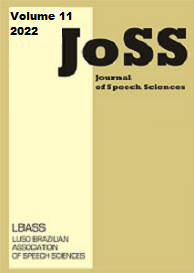Abstract
This article deals with the correspondence between words closed by [n] followed by a vowel-initial suffix (e.g., ca[n]al 'channel', tupi[n]ismo 'Tupinism') and their respective bases in Brazilian Portuguese (e.g., cano 'pipe', tupi 'Tupi'). The data sources for the analysis are the Corpus Brasileiro, representing the lexicon in use, and a pseudoword test, representing the potential lexicon. Two representational hypotheses are contrasted in the analysis of this correspondence: the abstract approach, in which the bases are assumed to be closed by a VN structure, and the concrete approach, according to which [n] is part of the base or a product of epenthesis. The selection of the pattern VN was assumed as the response variable in the statistical analysis. According to the logistic regression test, final-stress bases and mid and high vowels preceding [n]Vsuffix are predictors of the VN pattern for the two samples. In the potential lexicon, the interaction between high frequency lexical strings and the suffixes -icV and -ismV as well as the random variables 'participant' and 'pseudoword' also contribute to the selection of the base pattern VN. The results confirm the plausibility of the abstract approach in the analysis of [n]Vsuffix forms in Brazilian Portuguese.
References
Câmara Jr. JM. Para o estudo da fonêmica portuguesa. Rio de Janeiro: Organização Simões; 1953.
Câmara Jr. JM. Problemas de linguística descritiva. Petrópolis: Editora Vozes; 1969.
Câmara Jr. JM. Estrutura da língua portuguesa. 35. ed. Rio de Janeiro: Editora Vozes; 1970.
Lemle M. Phonemic system of the Portuguese of Rio de Janeiro. [Dissertation – Masters]. University of Pennsylvania; 1965.
Leite Y. Portuguese stress and related rules. [PhD]. University of Texas; 1974.
Cagliari LC. An experimental study of nasality with particular reference to Brazilian Portuguese. [PhD]. University of Edinburgh, Edimburgo; 1977.
Abaurre-Gnerre MBM. Alguns casos de formação de plural em português: uma abordagem natural. Cad. Est. Ling., Campinas. 1983;5:127-156.
Wetzels L. Contrastive and allophonic properties of Brazilian Portuguese vowels. In: Wanner D, Kibbee DA, editors. New analyses in Romance linguistics. Amsterdam: J. Benjamins, 1991.
Wetzels L. The lexical representation of nasality in Brazilian Portuguese. Probus. 1997; 9:203-232. http://dx.doi.org/10.1515/prbs.1997.9.2.203.
Wetzels L. Comentários sobre a estrutura fonológica dos ditongos nasais no Português do Brasil. Revista de Letras, Fortaleza. 2000;1(22):25-30.
Bisol L. A nasalidade, um velho tema. DELTA, São Paulo. 1998;14(nº especial):27-46. http://dx.doi.org/10.1590/S0102-44501998000300004.
Bisol L. A nasalidade fonológica no português e suas restrições. Diadorim, Rio de Janeiro. 2016;18:116-126. http://dx.doi.org/10.35520/diadorim.2016.v18n0a4050.
Huback AP. Plurais irregulares do português brasileiro: efeitos de frequência. Revista da Abralin, Curitiba. 2010a;9(1):11-40. http://dx.doi.org/10.5380/rabl.v9i1.52337.
Huback AP. Plurais em -ão do português brasileiro: efeitos de frequência. Revista Linguística, Rio de Janeiro. 2010b;6(1):9-26. http://dx.doi.org/10.31513/linguistica.2010.v6n1a4436.
Cristófaro-Silva T. Organização fonológica de marcas de plural no português brasileiro: uma abordagem multirrepresentacional. Revista da Abralin, Curitiba. 2012;11:273-305. http://dx.doi.org/10.5380/rabl.v11i1.32468.
Guimarães M, Nevins A. Probing the representation of nasal vowel in Brazilian Portuguese with language games. ORGANON, Porto Alegre. 2013;28(54):155-178. http://dx.doi.org/10.22456/2238-8915.38298.
Becker M, Nevins A, Sandalo F, Rizzato É. The acquisition path of [w]-final plurals in Brazilian Portuguese. J. Port Linguist, Lisboa. 2018;17(4):1-17. http://dx.doi.org/10.5334/jpl.189.
Rizzato É. Interação do plural de -ão e do aumentativo -zão na formação de compostos no português brasileiro. [Dissertation – Masters]. Instituto de Estudos da Linguagem, Universidade Estadual de Campinas, Campinas; 2018.
Gomes CA, Prado LO, Amaral TLA. Aspectos cognitivos e sociais da variação linguística na alternância de formas de plural de nomes do PB. In: Marins J, Orsini M, Cavalcante SR, editors. Contribuições à descrição e ao ensino do português brasileiro: da fonética ao discurso, com parada obrigatória na sintaxe - uma homenagem a Maria Eugênia Lammoglia Duarte. Rio de Janeiro: EDUFRJ, 2021.
Schwindt LC, Gaggiola PE, Petry IP. Frequência e distribuição de plurais irregulares no Corpus Brasileiro. Rev. Estud. Ling. 2021;29(2):1289-1324. http://dx.doi.org/10.17851/2237-2083.29.2.1289-1324.
Head BA. Comparison of the segmental phonology of Lisbon and Rio de Janeiro. [PhD]. University of Texas at Austin; 1965.
Matta Machado MT. Étude articulatoire et acoustique des voyelles nasales du portugais de Rio de Janeiro: analyses radiocinematographique, sonagraphique et oscillographique. [PhD]. Université de Sciences Humaines de Strasbourg; 1981
Vennemann T. Rule inversion. Lingua. 1972;29:209-242.
Possenti S. Via-rules: um problema metodológico para a fonologia gerativa. In: Atas do III Encontro Nacional de Linguística. Rio de Janeiro, Departamento de Letras/PUC. 1979.
Schwindt LC. Underlying representation of [w]-final words in Brazilian Portuguese: evidence from morphological derivation. Acta Linguistica Academica. 2021;68(1-2):139-157. http://dx.doi.org/10.1556/2062.2021.00482.
Cagliari LC, Massini-Cagliari G. A epêntese consonantal em português e sua interpretação na Teoria da Otimalidade. RELIN. 2000;9(1):163–192. http://dx.doi.org/10.17851/2237-2083.9.1.109-162.
Canfield SS. Breve descrição da epêntese consonantal em palavras derivadas por sufixação no português brasileiro. Cadernos do IL. 2018;56:57–69. http://dx.doi.org/10.22456/2236-6385.83495.
R Development Core Team. R: A Language and environment for statistical computing. R Foundation for Statistical Computing, Vienna, Austria. 2021. Available from: http://www.R-project.org.
Wickham H. Ggplot2: Elegant graphics for data analysis. New York: Springer; 2009.

This work is licensed under a Creative Commons Attribution 4.0 International License.
Copyright (c) 2022 Luiz Carlos Schwindt, Maria Bernadete Abaurre


